Submissions of 303rd Bomb Group related stories and articles are most welcome.



January 23, 2011
Volume III, Issue 1
www.303rdBG.com
ST. PAUL'S CATHEDRAL AMERICAN MEMORIAL CHAPEL DEDICATION
Sgt Victor G. Hand Among the 12 Honored at the 1958 Dedication
(some photos and historical information are courtesy of Jeanne Hand Henry)
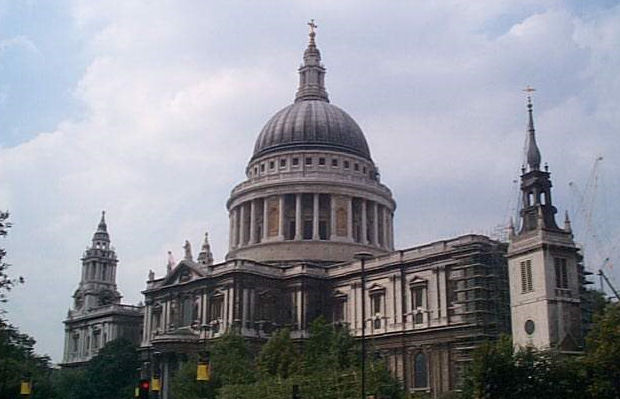
St. Paul's Cathedral in London
A cathedral dedicated to St. Paul has stood on the same site in London since 604 AD. The current cathedral – the fourth to occupy this site – was designed by the court architect Sir Christopher Wren and built between 1675 and 1710, after its predecessor was destroyed in the Great Fire of London.
At the east end of the Cathedral behind the High Altar is the American Memorial Chapel. This part of the building was destroyed during the Blitz and, when rebuilt in the 1950s, formed a chapel funded by the British people to commemorate the members of the United States forces based in Britain who gave their lives defending liberty during World War II.
The Chapel is also known as the Jesus Chapel, as the space was known prior to World War II.
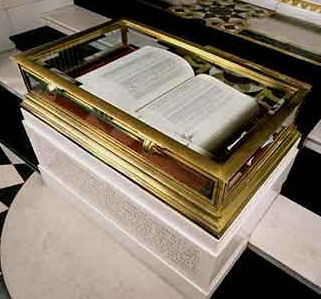 |
"This chapel commemorates the common sacrifices of the British and American peoples during the Second World War and especially those American service men whose names are recorded in its Roll of Honour. This tablet was unveiled by H.M. Queen Elizabeth II on 26 November 1958 in the presence of Richard M. Nixon the Vice President of the United States of America."
The American Chapel was designed by Stephen Dykes Bower and constructed by Godfrey Allen, Surveyor to the Fabric 1931-1956. The images that adorn its wood, metalwork and stained glass include depictions of the flora and fauna of North America and references to historical events. The three chapel windows date from 1960. They feature themes of service and sacrifice, while the insignia around the edges represent the American states and the US armed forces. The limewood panelling incorporates a rocket - a tribute to America's achievements in space.
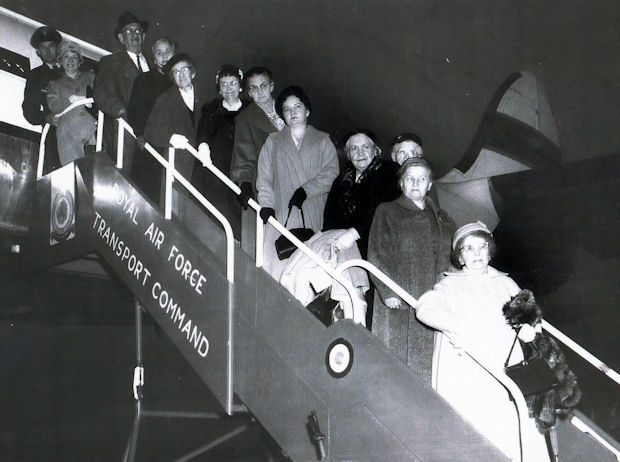
From the London Times, November 27, 1958:
The American Memorial Chapel in St. Paul's Cathedral, dedicated yesterday in the presence of the Queen and the Vice-President of the United States, Mr. Richard Nixon, was thus brought to the fullness of its completion as a consecrated place of pilgrimage.The first of the pilgrims might be considered those 12 American citizens who occupied the stalls of the chapel during the dedication service ; they had been selected from among the next-of-kin of the 28,000 American dead commemorated in the chapel's roll of honour and had been brought to Britain by air from distant homes as far apart as Massachusetts and California.
They were not without the company of their fellow countrymen in St. Paul's and, indeed, entered its great west door between the rinks of a guard of honour in which American soldiers, sailors, and airmen were the principal formation. Inside the cathedral, also, a representative contingent of the United States forces—men of the army from Germany and men of the air force from all parts of Britain as well as sailors from visiting ships—lent its distinctive and appropriate note to this special service.
The service of dedication had in it much to remind one of that other service on Independence Day in July, 1951, when General Eisenhower—he was then still an Allied commander—handed to the Dean of St. Paul's for safe keeping the American roll of honour that now has its place in the memorial chapel. The Queen, yesterday, immediately after the act of dedication, unveiled a memorial inscription incised on the marble pedestal supporting the gold case which contains the roll of honour ; it records that "this chapel commemorates the common sacrifices of the British and American peoples during the Second World War and especially those American service men whose names are recorded in its roll of honour."
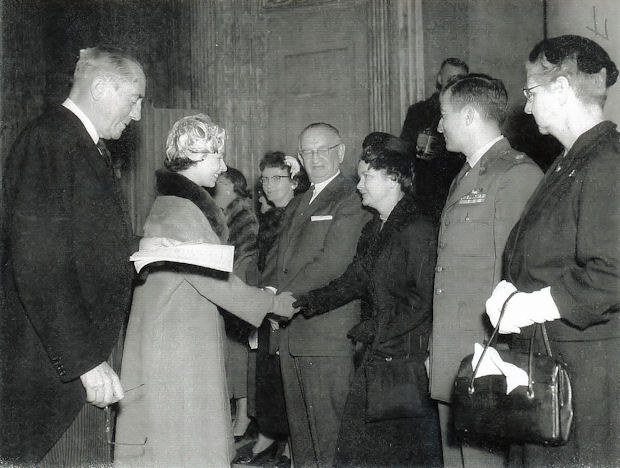
The 12 American citizens selected to be the first welcomed in the American Chapel were:
|
|
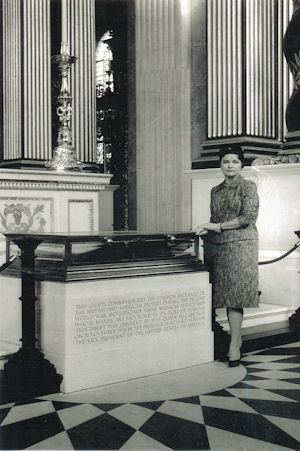
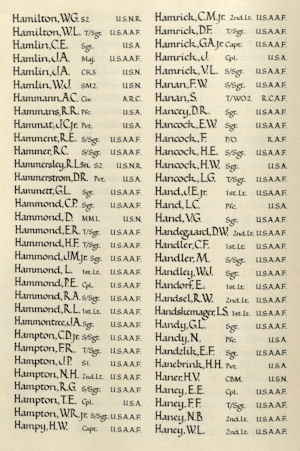
On the left, Mrs. Jeanne Hand Henry, sister of Sgt Victor G. Hand, stands by the case holding the
Roll of Honour. On the right is the page from the Roll of Honour showing Sgt Hand's name.
You can view all the Roll of Honour pages and search for names at: www.stpauls-roh.org.uk
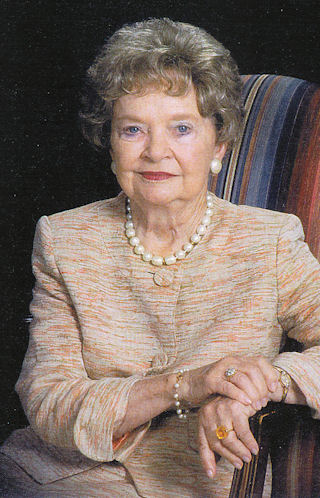
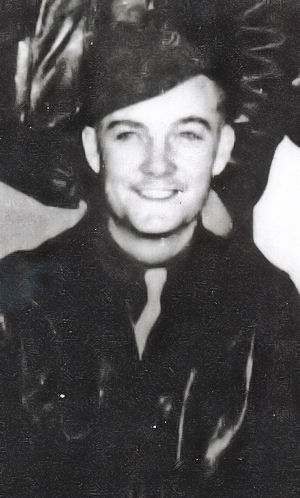
5 of the 35 Original Crews are Lost
Mission #11 — 23 January 1943
Lorient Port Area and Brest U-boat Pens, France
LtCol George L. Robinson led the 303rd BG attack with twenty-one B-17s. Intense heavy flak was encountered. About forty-five enemy fighters were seen with twenty-five attacks. Gunners claimed nine destroyed, five probables, and three damaged. Thirteen Group aircraft bombed the primary target at Lorient. One Group aircraft, #41-24587, Bad Check, 427BS (Capt. Southworth), dropped its bombs near Brest. Twelve of the aircraft returned to Molesworth. Several had one engine feathered. One aircraft had two engines out and feathered. Five were damaged by flak and enemy aircraft, three extensively.
#41-24569, Memphis Tot, 427BS (Capt. Cole), experienced severe aircraft damage, the radio went out, and the bombs were jettisoned when the bombardier determined that they wouldn't drop near the target.
Four aircraft landed at other fields:
- #41-24606 Werewolf 358BS: Lt. Oxrider ordered his crew of nine to bail out
over the south coast of England after limping home with only one engine operating.
He landed Werewolf on the grounds of a mental hospital at Dawlish. It was originally
thought to be beyond repair. The VIII Service command later decided to repair the
B-17 and fly it out. They changed three engines, and cleared trees, walls, and
hedges to make a 2,500 foot runway. The take-off was successful and it was flown
to Honington Air Depot for further major repairs. On April 22nd, after repairs were
completed, it was transferred to 91BG/401BS where it remained for two months.
There were no bailout or mission injuries.
- #41-24565 Idaho Potato Peeler 359BS: Lt. Bales and his crew crash-landed
their badly damaged B-17 at Chipping Warden. The aircraft made a safe landing
with no injuries.
-
#41-24579 Thumper 360BS: Lt. John Castle and Lt. Fitzsimmons, the copilot, made a belly landing in Thumper at Lulsgate Bottom. The hydraulic system and two engines were out. During the landing the rear fuselage twisted when the ball turret suspension frame was forced up through the spine aft of the radio room. The other eight crewmen had bailed out before the emergency landing. S/Sgt Billie L. Staner was killed when his parachute failed to open. Lt. C.L. Herman and S/Sgt Martin A. Semonick were slightly injured, and T/Sgt Levin and S/Sgt Craft were badly injured. Sgt Yannie's legs were crushed. He was found by a farmer and hospitalized.S/Sgt Billie L. Staner 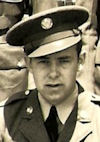
- #41-24587 Bad Check 427BS: Capt. Southworth made a safe, normal landing at Exeter with no injuries. The starboard inner engine had failed after being damaged by flak and both wings were damaged by cannon shells from FW-190s and ME-109s.
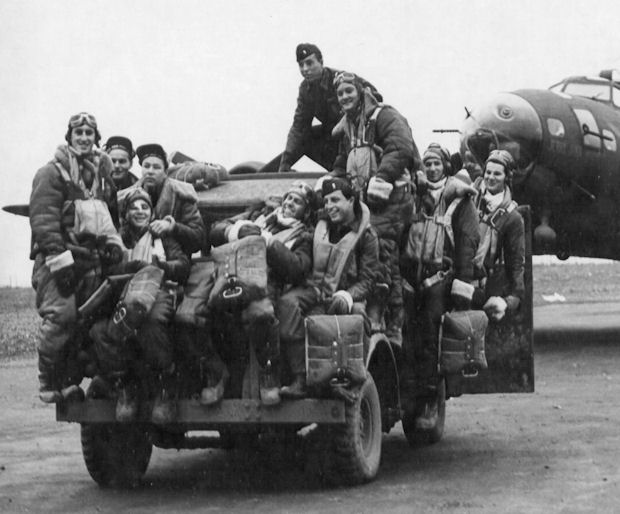
#41-24607 Jerry Jinx, 427BS (1Lt. Reber), was believed shot down by anti-aircraft guns. The aircraft ditched in the Bay of Biscay. All crewmembers were killed. S/Sgt. I.D. Blankenship and Sgt. R.W. Milford are listed on the Wall of Missing at Brittany American Cemetery near Manche, France. Lt. E.H. Reber, Lt. A.D. Mitchell, Lt. J.J. Byrom, Lt. R.J. Swindle, T/Sgt. D.L. Hamilton, S/Sgt. D.A. Mayo, S/Sgt. L.N. Gross and Sgt. V.G. Hand are listed on the Wall of Missing at Cambridge Cemetery, England. The airport at Walnut Ridge, Arkansas was named "Swindle Field" in honor of Lt. Swindle.

#41-24580 Hell Cat, 358BS (1Lt O'Connor) was shot down by enemy fighters. It was seen with the No. 4 engine feathered and the No. 1 engine smoking. The aircraft went down in the region between Brest and the coast. Eight parachutes were seen to open. Lts. Ruppe and Gordon evaded capture and returned on 14 March 1943. The other crewmembers became prisoners of war.
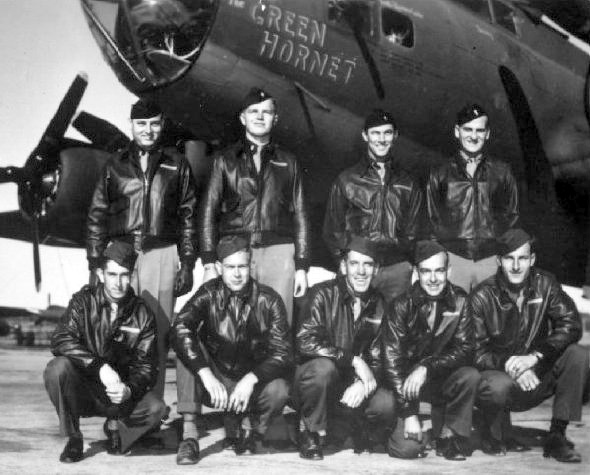
#41-24603 Green Hornet, 359BS (1Lt. Sanderson), was first hit by flak, causing loss of three engines. After leaving the formation, it was hit by FW-190s head-on from 12 o'clock. The crew, except for the pilot and co-pilot, bailed out. Lts. Sanderson and Bowman had only one parachute between them and they both elected to stay with the B-17 for a crash landing. Green Hornet crash landed on the side of a hill at Kergolay, in Motreff, France. Lt. Sanderson lost some of his fingers.
Lt. Spence and T/Sgt. Devers found a friendly family in Paule, France, who welcomed them into their home, put them in contact with the Underground and kept them hidden for fifteen days. They then walked by night following a canal, slept by day, and arrived near Chateau de Quellennec, in St. Gilles de Vieux Marche. They boarded a train, ended up in Paris, and, with the help of brave Frenchmen, took a risky journey by train to Spain. The final journey was back to Molesworth. T/Sgt. Devers returned on 23 March 1943 and Lt. Spence on 3 Apr 1943. Two others also evaded capture: T/Sgt. Jones returned on 13 May 1943 and S/Sgt. Greene on 21 August 1943. S/Sgt. J.L. Markiewicz, who parachuted and landed, died on 12 February 1943.
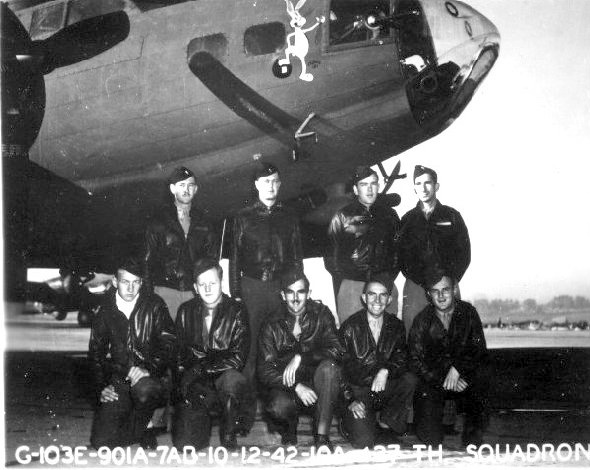
#41-24584 Susfu, 427BS (1Lt. Robey), was shot down by a FW-190 two thirds of the way between Lorent and Brest. The aircraft was seen going down under fair control. Lt. H.A. Robey and Lt. R.R. Moser were killed. Lt. M.L. McDermott and S/Sgt. S.L. Vogel evaded capture by the enemy. The other members of the crew evaded capture for a period of time, but were subsequently captured and held as prisoners of war.
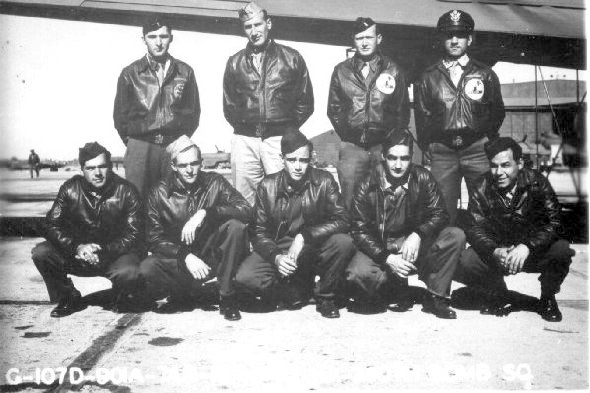
 |
A subsequent attack by German FW 190s occurred after the formation broke up to avoid being hit by bombs. The attack killed 1Lt Haas (P) and 2Lt Christianson (CP). The plane nosed over and started down in a slow spin and crashed in a forest near Pluvigner, France. Three Crewmen managed to bail-out and became POWs. The others were all killed.
1Lt Joseph E. Haas (KIA), was an original 358th BS Pilot on his 6th credited mission substituting for 1Lt Louis M. Schulstad, Jr. who had been hospitalized with the flu.
 |
1Lt Joseph E. Haas, 2Lt Roy W. Christianson, T/Sgt. Antone Pacheco, S/Sgt Peter Soria,
Sgt. Jerry W. Dobbins, S/Sgt John Sherman, and S/Sgt Wayne O. Stevens were killed and
are buried as a group at Rock Island, IL National Cemetery. 2Lt John H. Embach, 2Lt
Ewell R. McCright and S/Sgt Charles L. Roth were captured by the enemy and taken
prisoner. 2Lt Embach was killed in action in Korea on 28 February 1954.
By Charles L. Roth
(originally published in the 303rd BGA's Hell's Angels Newsletter, August 2005)
Our last mission was on the 23rd of January, 1943. Molesworth to Lorient, France, to bomb submarine pens.
Our pilot this day was Lt. J. Haas, standing in for Lt. L. M. Schulstad, and another stand-in was the bombardier, Lt. E. McCright for Lt. R. Saiz.
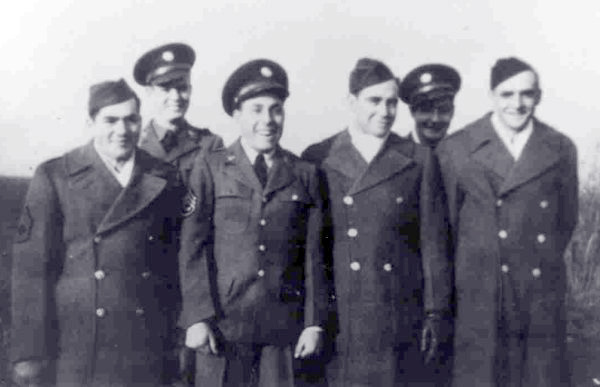
About 1:30 PM, on the bomb run, approaching target, our plane was hit in the tail section by a bomb from the plane above. The impact of the bomb turned the plane upside down. I almost fell out the top of the radio room gun port. I saw the bombs above us just before we were hit.
After Lt. Haas righted the plane, I got up from the floor and assisted the ball turret gunner, Sgt. P. Soria, out of the turret and put his chute on him. He headed for the rear escape door. I then noticed that the right waist gunner, Sgt. J. Sherman, was hanging outside the plane, I went to help him, but, as I reached for his leg, his body fell away from the plane. Surely, he was unconscious or dead.
I took over Sherman's gun position. Sgt. T. Dobbins, left waist gunner, handed me Sherman's oxygen mask. I took the hose, and then both Dobbins and I started firing at the enemy planes circling us. It seemed there were a half dozen of them.
I later found out there were two FW 190s. I saw some of my tracers hit one of the planes and I did see some smoke.
Before taking over the gun position, I looked down toward the tail and saw that the gunner, Sgt. W. Stevens was slumped over and one shoulder looked as if it was gone. I knew he was dead.
Our plane seemed to be losing more speed. I noticed our engineer, Sgt. A. Pacheco, in the bomb bay. I thought perhaps he was checking on us, but later found that he was salvoing the bombs to lighten the load. It seems another seven to ten minutes lapsed and then Beats Me quit flying, nosed over and started straight down. I left the waist gun and with difficulty made my way to the rear escape door. Soria had either been hit or was unconscious.
The door handle had not been released. I pulled the handle and tried to get out. It seemed impossible. I was half in and half out when something came off the wing, probably part of the deicer boot, and hit me in the head, knocking and jerking me out.
I thought surely I must be close to the ground. I was spinning around very fast and pulled the rip cord, opening the chute too soon. The tremendous jerk broke a leg strap, and whipped off a boot and a shoe. Worst of all, a long tear appeared in the top of my chute. It was difficult to control. A German fighter pilot circled me, and was close enough that I could see his face. As he circled the second time, I saluted him. He saluted back and flew off.
I watched our plane as it plunged toward earth. I kept hoping to see another chute. One came out and opened just before Beats Me hit the ground. There was no one in it. When the B-17 hit, it looked like a huge implosion. One wheel bounced back up from the ground to a tremendous height.
I feel I was at least eight or ten minutes reaching the ground. I landed three or four miles from the crash site. Ten or more Frenchmen had been gathering and were waiting for me to land. I almost landed in a deep hole. I was able to maneuver just enough to miss it and was in almost a free fall for about twenty feet. I hit hard.
Two of the Frenchmen, young boys, helped me out of the chute and led me across some fields and hid me in the loft of a barn. One of the boys brought me cider about 4:30 that afternoon.
Around 6:30 I was taken into the house and given bread and wine. There were six or seven people sitting around the table. I knew they were friendly, but not being able to speak the language puts a new meaning into frustration and the feeling of "being lost" and wondering if they could help me. The English they knew "Babe Ruth, Jack Dempsey and President Roosevelt."
At 7 o'clock, a truck load of Germans drove into the yard. They took me to a prison in the city of Vannes. That day I had lost seven comrades. I was still alive, but had no idea what was in store for me. After three days, during which I heard and saw through a small window French people being shot, and wondering if I was next, I was taken to a train station and sent to Dulag Luft on the Main.
I was joined on the train by Lt. John Embach, navigator, and Lt. Ewell McCright, our stand in bombardier. McCright had a foot wrapped and did no talking. I said very little to Lt. Embach as the Germans did not want us conversing.
After three days of interrogation, proving to me that they knew more about me and my family than I did, I was sent to Stalag 8-13 at Tesen, Poland, for the start of 27 months of captivity.
During one of the transfers between camps, two buddies, Clair "Rusty" Swarmer and Paul Giddens, and I climbed out the little window of a prison box car and jumped in the dark. Paul lasted two days. Rusty and I, with a few harrowing experiences, lasted for 10 days.
Rusty had pneumonia and I was not much better off. We turned ourselves in. Three nights in a good warm cell helped a lot, but 14 days on bread and water after being sent to Stalag 7-A made us wonder just what we did do.
From there we were sent to Stalag 17-B, my last camp.
Freedom came at the Inner River after approximately a three weeks march living as best we could. Everyone was without food. We foraged the countryside and had whatever the Germans would trade for tea or a shirt.
The first GI's we saw sure did look mighty good and the GI food was heaven. There are so many things that could be related. I can still hear the wonderful sound of our planes going over the camp and knowing that America was persevering.
Of my two fellow 360th -crew POW's, Lt. McCright has passed away and Lt. Embach died in the Korean conflict.
I am sure that there will be an ongoing story until the day that I die. There are still so many more questions for which I would like to find answers.
![]()
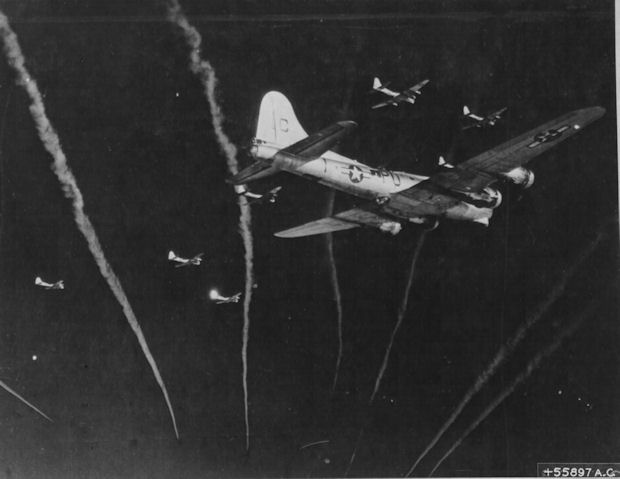
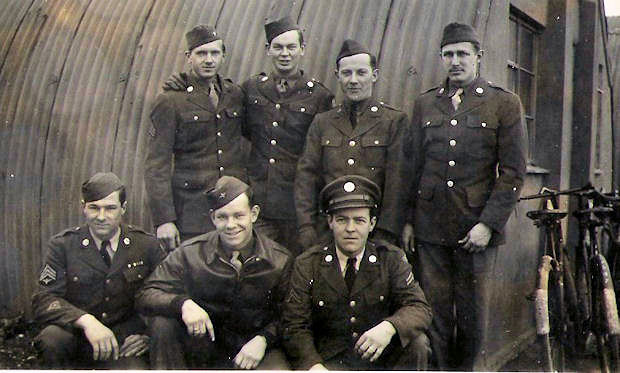
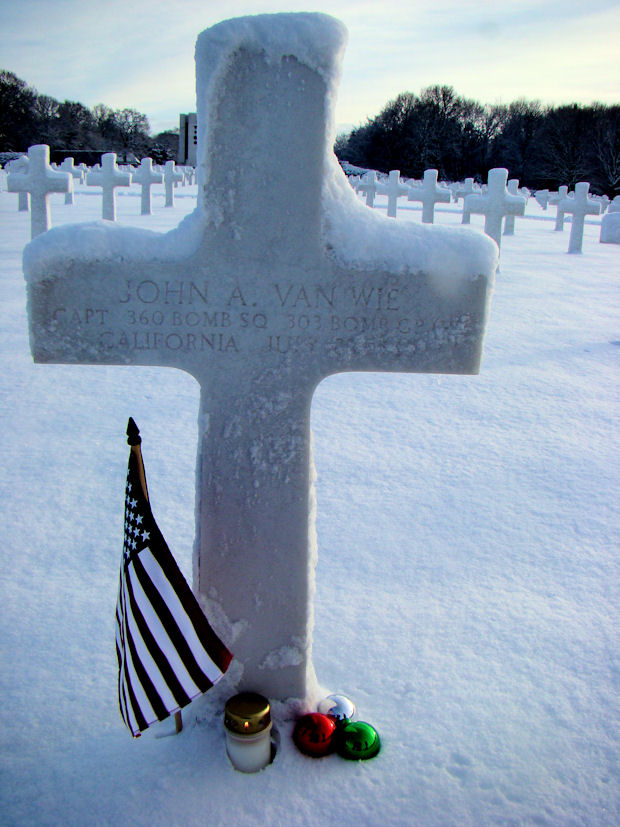
Martijn has truly gone the extra mile in honoring those who gave their lives for freedom. He has adopted a total of 25 graves at three American Cemeteries: Ardennes and Henri-Chapelle in Belgium, and the Netherlands American Cemetery in Margraten. His website, dedicated to the fallen liberators of WWII, is here: www.facesbeyondthegraves.com
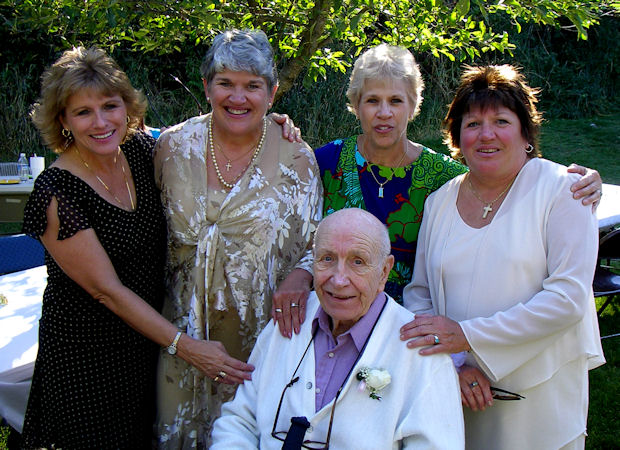
Happy 90th Birthday, Walt!
Walt Mayer with his daughters Amy, Kathy, Kristy and Wendy. Walt turned 90 on January 22nd.
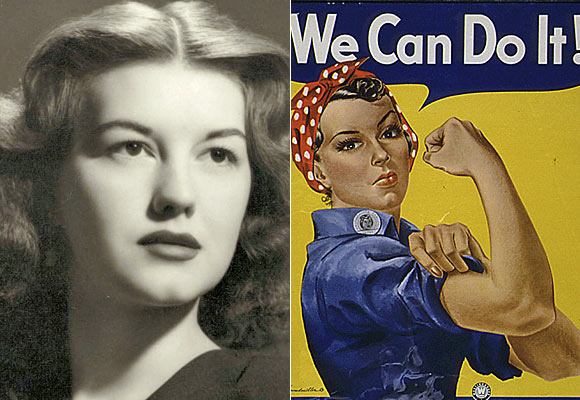
Geraldine Hoff Doyle, a World War II factory worker whose bandana-wearing image in a wire-service photo is said to have been the model for the woman depicted in the 1942 "We Can Do It!" poster, has died. She was 86. The iconic wartime poster became an enduring symbol of women's power from the Rosie the Riveter era.
Doyle died of age-related causes Sunday at Hospice House of Mid-Michigan in Lansing, said her daughter, Stephanie Gregg.
Doyle was a 17-year-old high school graduate when she took a job at the American Broach & Machine Co. in her hometown of Ann Arbor, Mich., in 1942, a time when millions of women across the country were going to work to replace men who had gone to war.
"She had just graduated, and some of the young men had left school to volunteer to fight," Gregg said. "A couple had been killed, and she felt she wanted to do something for the war effort."
Doyle was operating a metal-stamping machine when a United Press photographer took a picture of the tall, slender and glamorously beautiful brunet wearing a polka-dot bandana over her hair.
Her photo, according to an account on the Pop History Dig website, was seen by Pittsburgh artist J. Howard Miller, who was commissioned by the Westinghouse War Production Coordinating Committee to create a series of morale-building posters to inspire Westinghouse factory workers.
Miller's "We Can Do It!" poster portrays a woman in a red-and-white polka-dot bandana and a blue uniform, rolling up a sleeve over a flexed right bicep.
Gregg said her mother, who was not as muscular as the woman depicted in the poster, had no idea her photograph had been used as a model for Miller's poster until the mid-1980s.
"She was tickled to recognize that she was the inspiration for so many women," said her daughter.
Doyle, who was born July 31, 1924, in Inkster, Mich., actually worked in the factory only a couple of weeks; a cello player, she quit after learning that the woman she had replaced had injured her hand on the metal press, her daughter said.
She then got a job at a bookstore in Ann Arbor, where she soon met her future husband, Leo H. Doyle, who was in dental school. They were married in 1943 and had six children. Doyle also worked as the office manager at her husband's dental office until she was 75.
The "We Can Do It!" poster image has been reproduced frequently in recent decades on a variety of items, including on a U.S. postage stamp issued in 1992.
![]()
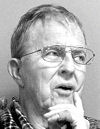 Robert R. "Bob" Higgins was born on November 3, 1924 in Tacoma, Washington. He passed away on January 11, 2011 and is survived by his wife of 59 years, Peggy, children Ted and Dan Higgins and Connie (Mat) Reitzug, 3 grandchildren, and 3 great-grandchildren. The family would like to thank Dr. Loomis, the staff at Hospice, and all other caring professionals that helped our family throughout Bob's final illness. Bob will be interred at Tahoma National Cemetery. [359th BS - S-2 staff]
Robert R. "Bob" Higgins was born on November 3, 1924 in Tacoma, Washington. He passed away on January 11, 2011 and is survived by his wife of 59 years, Peggy, children Ted and Dan Higgins and Connie (Mat) Reitzug, 3 grandchildren, and 3 great-grandchildren. The family would like to thank Dr. Loomis, the staff at Hospice, and all other caring professionals that helped our family throughout Bob's final illness. Bob will be interred at Tahoma National Cemetery. [359th BS - S-2 staff]
 Christ M. Christoff, age 89 of Merrillville, IN, passed away Friday, Jan 7, 2011. (just 5 days shy of his 90th Birthday) He served as ground crew for the 303rd Bomber Group during World War II. He earned EAME Theather ribbon and six bronze stars.
Christ M. Christoff, age 89 of Merrillville, IN, passed away Friday, Jan 7, 2011. (just 5 days shy of his 90th Birthday) He served as ground crew for the 303rd Bomber Group during World War II. He earned EAME Theather ribbon and six bronze stars.
Preceded in death by his loving wife, Mary Christoff of 62 years or marriage. She passed away May 13, 2009. Survivors include son Chris Christoff, four daughters: Catherine Leisenheimer, Mary Ellen Shestak, Christine Sertic, and Joan Skotnicki, nine grandchildren, and eleven great grandchildren.
Mr. Christoff retired from U.S. Steel Gary Works with 40 years of service. He enjoyed fishing, photography, writing, model airplanes, playing cards, watching football, and always telling jokes to put a smile on your face. His life and funeral were celebrated on his 90th Birthday, January 12, 2011.
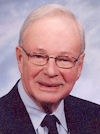 Raymond J. Martens, age 93, of Council Bluffs, passed away Sunday, January 2, 2011.
Raymond J. Martens, age 93, of Council Bluffs, passed away Sunday, January 2, 2011.
Ray was born in Council Bluffs, on January 5, 1917, to Herman and Grace Longeway Martens and graduated from Abraham Lincoln High School in 1935. He attended Washington University in St. Louis and served his country during WWII as a Flight Engineer in the 303rd Bomb Group, US Air Force.
Ray retired from Union Pacific Railroad as an Architect after 43 years of service. He is a member of St. Peters Church. He is survived by cousins, Margaret "Peg" Johnson, of Omaha, Neb., Kathleen Langston (Gary), of Columbia, S.C., and their children, Gary Langston Jr. (Jamie), Mark Langston (Hilary).
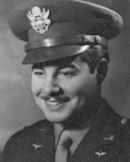 Lt. Colonel (Ret.) David S. Clifton, passed away at age 90 on December 30 at John Knox Village in Pompano Beach, Florida, where he lived for the past 9 years. He was born in Frenches Creek, Bladen County, NC on May 3, 1920.
Lt. Colonel (Ret.) David S. Clifton, passed away at age 90 on December 30 at John Knox Village in Pompano Beach, Florida, where he lived for the past 9 years. He was born in Frenches Creek, Bladen County, NC on May 3, 1920.
After graduating from Warsaw High School as Senior Class President in 1938, he attended North Carolina State for six months before he was called up 10 days after Pearl Harbor.
He served as a B-17 pilot and flew 25 combat missions between March and August 1943 with the 303rd Bomb Group, Hell's Angels, based in Molesworth, England. Two of his most memorable combat missions were on 11th June 1943 to Wilhelmshaven, where, after being knocked out of formation and attacked by 15 FW-190's, he landed with 96 bullet holes and on 17th August 1943 to Schweinfurt ball bearing works, with no long-range fighter escort resulting in 60 of the 315 B-17s being shot down. After the war the importance of the Heroya mission (on the 24th of July 1943) was revealed. Clark Gable also flew this mission that destroyed the production complex at Heroya that had produced heavy water for use in German nuclear research. Dave was awarded the Distinguished Flying Cross and Air Medals. Following his discharge from the service, he used the GI Bill to continue at North Carolina State and became the first in his family to graduate from college. He then went back into the Air Force where he served until he retired.
Dave loved flying, the guitar, and golf. When he was twelve years old he bought a $3.98 guitar and taught himself to play. While flying to England during WWII he played the same guitar over the intercom to keep his crewmembers awake. Each night before lights out in the quonset hut, he played some ragtime guitar to help everyone relax.
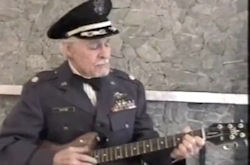 At 90 years old he starred in a YouTube video singing about the war, life, and love in his version of "The Last Farewell." We will fondly remember the concerts he staged during family visits. His musical performances included music that ranged from the oldies, country western, to his own songs. Also, we will miss our golf swing coach, as will his friends at the Pompano Beach Golf Course.
At 90 years old he starred in a YouTube video singing about the war, life, and love in his version of "The Last Farewell." We will fondly remember the concerts he staged during family visits. His musical performances included music that ranged from the oldies, country western, to his own songs. Also, we will miss our golf swing coach, as will his friends at the Pompano Beach Golf Course.
Dave is survived by his "inspiration" and wife of 68 years, Ruth Centelle Parker Clifton; his 3 children: David (and spouse Eileen), Daniel (and spouse Rannah), and Elizabeth; 5 grandchildren: Mark, Dana, Michael, Lindsay, and Jonathan; and 4 great-grandchildren: Rajie, Cody, Lily, and Caeden. He will be interred at Arlington National Cemetery with full Military Honors.
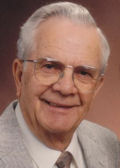 Russell F. Terrell, 86, of Carmi, passed away Jan. 1, 2011, at Phoenix Rehabilitation and Nursing Center in Carmi.
Russell F. Terrell, 86, of Carmi, passed away Jan. 1, 2011, at Phoenix Rehabilitation and Nursing Center in Carmi.
He was born Jan. 31, 1924, in Fairfield, the son of Frank and Hattie (Atteberry) Terrell. He married Joan Bills on May 5, 1945 in Northampton, England, and she survives. Russell graduated from Fairfield High School and attended Southern Illinois University before enlisting for military service, serving with the 303rd Bomb Group.
Mr. Terrell was an electrician who owned and operated Terrell Electric from 1967 until his retirement in 1984. He continued to work for several years after transferring the business to his son. He was a member of the American Legion and was a lifetime member of the VFW. He was a member of Concord Methodist Church.
He is survived by his wife, Joan of Carmi; a son and daughter-in-law, Mervyn and Gail Terrell of New Haven; three daughters and sons-in-law, Linda and Bill Hall of Concord, Debbie and Roy Dill of Newburgh, Ind., and Laurie and Randy Frashier of Maunie; nine grandchildren and their spouses, Shelley and Mitch Wilson of Raleigh, N.C., Jason and Jennifer Hall of Anna, Heather Wheeler of Carmi, Hollie and Kirby Damery of Carmi, Hilary and Paul Morgan of New Haven, Chad Dill and Katie Dill, both of Newburgh, Ind., Erin and Ian Haley of Carmi, and Eli Frashier of Maunie; nine great-grandchildren, Madison Wheeler, Lexi Wheeler, Annabelle Morgan, Ethan Morgan, Emslee Damery, Kyle Hall, Kaylee Hall, Jake Smull and Oliver Wilson; and many other relatives and friends.
He is preceded in death by his parents and two sisters, Irene and Eveyln.
A funeral service will be held at 11 a.m. Wednesday, Jan. 5, 2011, at New Beginning Church of God in Carmi. Visitation will be held from 4 to 8 p.m. Tuesday at Stendeback Family Funeral Home/Kittinger-Fair in Carmi. Burial will take place in Big Prairie Cemetery near Carmi. Military burial rites will be provided by American Legion Post 224 and VFW Post 3851 of Carmi. Contributions may be made to Disabled Veterans and may be left at the funeral home.
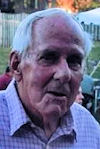 Wellington W. "Mac" Mikulski died February 25, 2010; beloved husband of the late Nancy M. (Falgiano); father of Paul (June), David (Susan), Lynn (John) Conway and Mark (Molly) Mikulski; grandfather of Jennifer (Stephen) Sorrentino, James Mikulski, Jaclyn Mikulski, William Conway, Andrew Mikulski, Brian Mikulski, Erin Conway, Sarah Mikulski, Kerry Conway, Alexis Mikulski, Shannon Conway and Scott Mikulski; great-grandfather of Julia Sorrentino; brother of Mary Wagner; predeceased by other brothers and sisters. Friends may call Saturday and Sunday 3-7 PM at the DENGLER ROBERTS PERNA FUNERAL HOME, 8630 Transit Rd., East Amherst (one mile north of Maple just past Klein Rd.) where prayers will be offered Monday at 9:45 followed by a Mass of Christian Burial from St. Gregory the Great RC Church at 10:30. In lieu of flowers, memorials may be made to Camp Good Days and Special Times Headquarters, 1332 Pittsford-Mendon Rd., Mendon, NY 14506.
Wellington W. "Mac" Mikulski died February 25, 2010; beloved husband of the late Nancy M. (Falgiano); father of Paul (June), David (Susan), Lynn (John) Conway and Mark (Molly) Mikulski; grandfather of Jennifer (Stephen) Sorrentino, James Mikulski, Jaclyn Mikulski, William Conway, Andrew Mikulski, Brian Mikulski, Erin Conway, Sarah Mikulski, Kerry Conway, Alexis Mikulski, Shannon Conway and Scott Mikulski; great-grandfather of Julia Sorrentino; brother of Mary Wagner; predeceased by other brothers and sisters. Friends may call Saturday and Sunday 3-7 PM at the DENGLER ROBERTS PERNA FUNERAL HOME, 8630 Transit Rd., East Amherst (one mile north of Maple just past Klein Rd.) where prayers will be offered Monday at 9:45 followed by a Mass of Christian Burial from St. Gregory the Great RC Church at 10:30. In lieu of flowers, memorials may be made to Camp Good Days and Special Times Headquarters, 1332 Pittsford-Mendon Rd., Mendon, NY 14506.
![]()
Good Afternoon Gary,Keeping the Legacy Alive,I wrote to you a couple times in the past 2 years on asking questions on videos you posted on the website. My grandfather was Christ Christoff. I and other family members were able to spend Christmas with him. To his last days, he was always carrying around his photo album of his war photos from the 303rd Bomb Group. He was so proud, and so were we! He was always showing other people his photos and explaining them in great detail. I know he contributed many photos to you and your website. He also contributed a diary for your website. His last year included many stays in the hospital and nursing homes. Since he did not have access to the internet, I always printed out the email you sent out once a month. I either mailed them or hand delivered when I was visiting him in the hospital / nursing home. The family of Christ Christoff are thankful for all the work you have done on it. I receive your email each month and look forward to the next.
Once again thank you for all that you've done to keep the memories alive of all the war heroes of the 303rd Bomber Group. I just wanted to emphasize that Christ loved to show of his photos and love telling stories about the war. He was also very fond of your website. I always loved to listen to his stories. To his last days, he was coherent and always telling jokes and stories. We will miss him greatly.
Joseph G. Shestak
Grandchild of Christ M. Christoff
Hi Gary,
Best wishes for good health and happiness in the new year. We send greetings to all of our 303rd friends and thank you, Gary, for your continued effort on the wonderful newsletter. Walt reads each one we print for him.
Dad will be 90 years young on the 22nd of January and is doing well. Family gatherings are enjoyable for him. He has been living with us since June of 2010. We miss the reunions seeing old friends, and reminiscing about the old days.
Fred and I were married on 12 September 2010 at his house. The wedding was attended by about 160 family and friends. Share with anyone you would like. Hope this finds your family all healthy, Hello to Susan and all.
God's blessings to you and yours and Happy New Year.
Live, Laugh and Love.
Fred and Kathy (Mayer) (Johnson) Glaesemann and Walt
Dear Gary,
Thank you for the mention of my uncles, John and Robert Hull in your article in the Molesworth Pilot. A couple additions and clarifications for the record. The last mission for Mr. Five-by-Five was mission #23 for my uncle John. During a trip to the cemetery at Margraten in 2004, I made contact with a man named Frenk who works at the American Cemetery. He was able to unearth the records of temporary graves on Terschelling where the bodies of men who were retrieved were buried during the war prior to their reinterment at Margraten and other American cemeteries. I have a copy of those records if you might be interested. I have also made contact with a man who lives on the next island to the north and who recently wrote a short article for their newsletter.
As a point of clarification, John's grave was adopted by a young man named Chrit who is about thirteen years old. I have received one email from him, but he was not comfortable with corresponding regularly.
Ironically my other uncle, Robert, was also on the mission to Bremen, his second credited mission. He was a B-24 pilot flying out of Wendling in Liberty Belle II for that mission. He completed only nine missions before his plane, Outhouse Mouse, was attacked over the North Sea on the return trip to England. They were part of a combined raid of 439 B-17’s and 130 B-24’s to attack the port and shipyards at Kiel, Germany. The Germans hit the bombers with over 50 fighter planes of various types and the anti-aircraft fire was intense. The final attack came near Helgoland and, with the plane on fire, Robert was forced to turn back toward Denmark. Staff Sergeant George Bacon, flying as tailgunner with the Detrick crew in A/C 599, witnessed the attack and saw the plane turn back to the west.
Contemporaneous accounts from German soldiers say that Robert attempted to dead stick the 24 onto a snow covered field just south of the Danish border, but hit a hidden creek and rolled the plane up. The several hundred gallons of avgas went up and all hands were lost. We have received contemporary photos of the crash site and the locations of the temporary graves.
Thanks again for your article. I will forward it to my father.
Paul Hull
Gary,
Thank you for sending your latest newsletter. I recently visited the 303rd web site since many of the aircraft were shared by the 384th BG. Mostly they were re-assigned from the BAD thus some served as many as four Groups during their careers.
Your newsletter is one of the very best I have seen. I started research for a few members of the 384th back in 1995 and at that time did research on crews by phone since the home computers were not in many homes. Fortunately many of the members were still living at that time and the cooperation with former members was terrific. I started an interactive newsletter entitled "Memories" and provided 20 pages per month of stories and photos. It caught on quickly and soon I had 600 subscribers, mostly 384th people but not limited to any group. After 5 1/2 years the e-mail provided so many veterans the opportunity to do their own research that I ended the newsletter and worked in conjunction with the newly started 384 web site.
Now retired for over 10 years, I am providing aid to family members of former airmen. Most of my basement is full of WW-II aviation photos and documents from many groups, both fighter and bomber. My network of friends has reached into parts of Europe and those people are still anxious to help with facts and photos from there.
Your great story entitled "Under the Klieglight" is a fine piece of work. I have recently been gathering information on the Post War base at Istres, France entitled "The Green Project". Many B-17 war veterans flew from there after the war and I have a fairly complete list of tail numbers and many photos from there. Matching the nose number ID with the tail numbers is my latest endeavor and I noticed the small "50" on the nose of the B-17 in your article. Though it is smaller than the size I have seen from Istres aircraft, it is larger than most nose numbers which represented the last three digits of the tail number. Could you provide any information on the photo?
Sincerely,
Ken Decker
384th BG Research Specialist
Hi Gary,
I must say a very big ‘thank you’ to you for keeping alive the 303rd Bomb Group (H) legacy, with your excellent, internet publication ‘The Molesworth Pilot’. Having been associated with the Association since 1979 I now very much miss the wonderful fellowship I had enjoyed with so many of its members, at the many reunions I have attended over the past 31 years.
When the 303rd BG Association disbanded I was concerned that I would lose touch with all matters concerned with the Association, but your inspired creation of ‘The Molesworth Pilot’ has enabled me to, as it were, stay-in-touch with things. You have my total admiration for all that you, and your family, are doing to keep the 303rd BG legacy alive. As we Brits say, ‘you are a fine chap’. (For those of your readers who are not familiar with our strange way of speaking – for ‘chap’ read ‘guy’.) Those of your readers who served over in the UK during the war years, the word ‘chap’ will be familiar with this word!
If any of 303rd veterans, or their families, ever make a trip to the UK, please do not hesitate to call me (44-1603 720980), or e-mail me at ray@thecosseys.co.uk I will be pleased to meet up with any of you who might be visiting the East Anglia region.
Warmest best wishes,
Ray Cossey

|